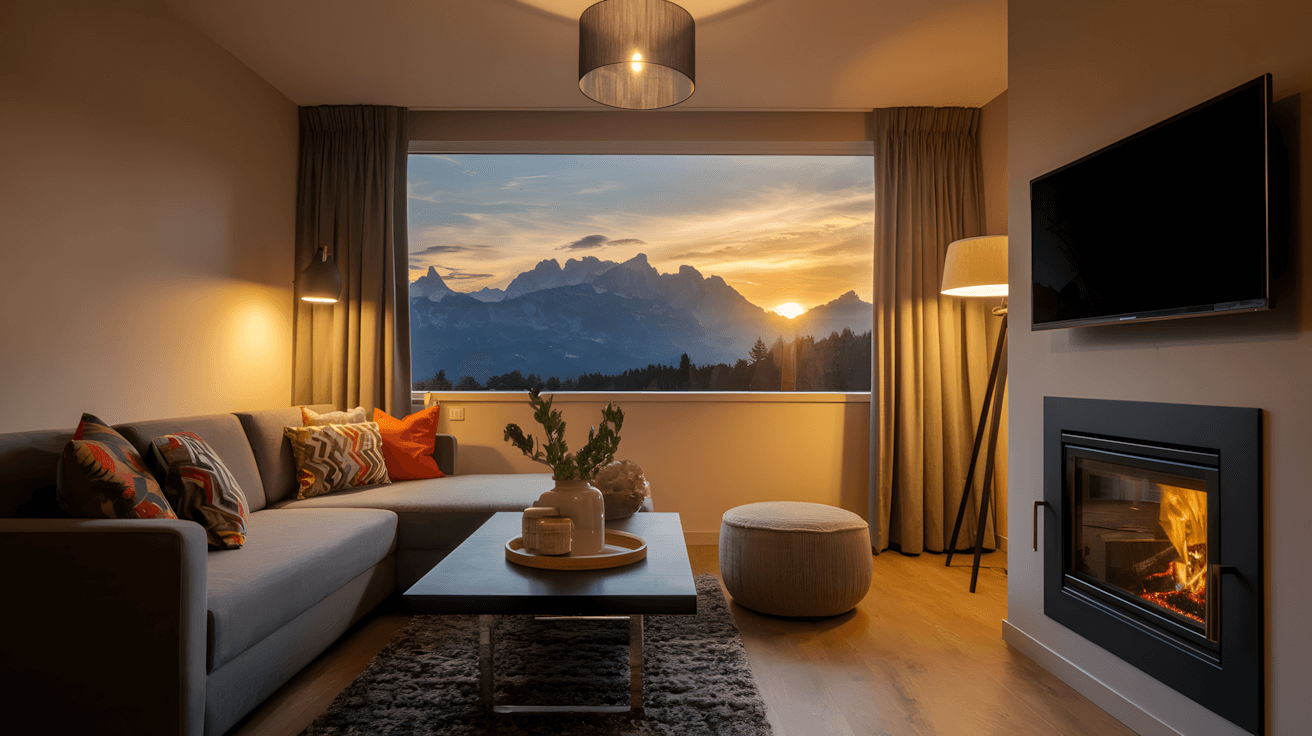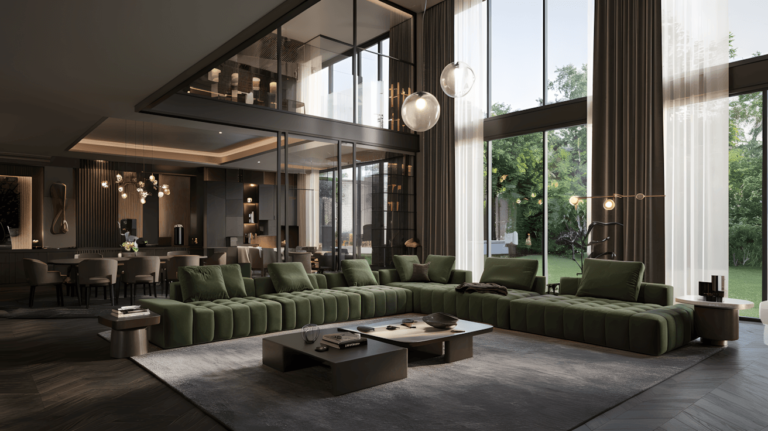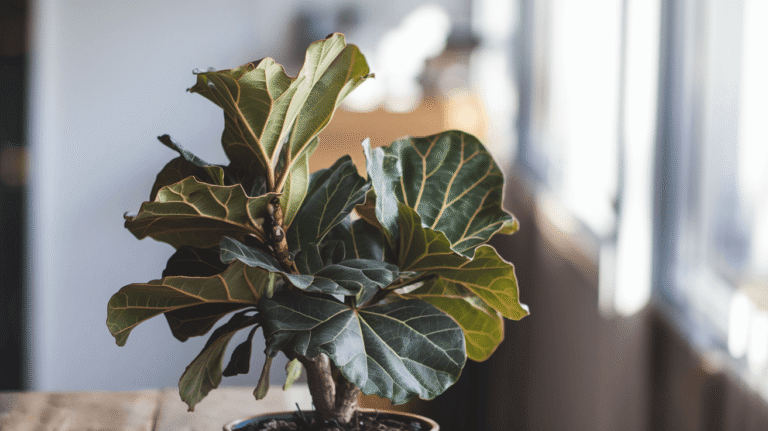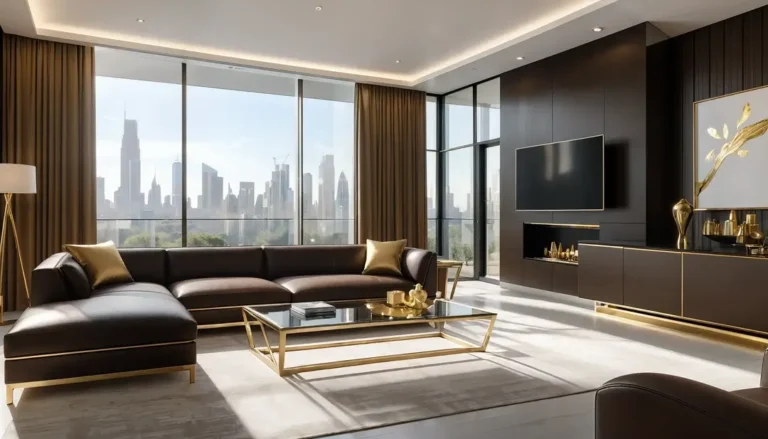After designing Nordic-inspired interiors for homeowners seeking authentic Scandinavian style, I’ve discovered that creating genuine Nordic spaces requires understanding both the cultural philosophy behind the aesthetic and the practical realities of living in these climates.
Many “Scandinavian” designs miss the essential functionality that makes this style so enduringly successful.
From my experience working with families on Nordic-style renovations, I’ve learned which Instagram-worthy elements lack the practical foundation that defines authentic Scandinavian living, and which time-tested design principles genuinely create the comfort, functionality, and well-being that Nordic design is known for.
These 25 interior ideas represent solutions that successfully balance authentic Nordic character with modern livability.
Understanding Authentic Nordic Design Philosophy
Nordic interior design emerged from practical necessity in harsh climates with limited daylight. The emphasis on natural materials, light colors, and uncluttered spaces serves specific functions: maximizing precious natural light, creating psychological warmth during long winters, providing efficient heating and maintenance, and supporting mental well-being through connection to nature.
Modern Nordic interiors succeed when they honor these functional origins while adapting to contemporary needs.
Living Space Foundations
1. Modern Living Room with Natural Integration

This approach demonstrates how Nordic design balances contemporary comfort with natural material authenticity.
Key Functional Elements:
- Neutral sectional for versatile seating – provides comfortable gathering space that adapts to various activities and group sizes
- Wooden coffee table for authentic material connection – adds natural warmth while providing durable, functional surface
- Large window for natural light maximization – essential for mental health and energy efficiency in Nordic climates
- Brick wall for thermal mass – provides heat retention and authentic texture that improves with age
Nordic functionality: Natural materials serve both aesthetic and practical purposes—wood provides warmth and acoustic benefits, while brick offers thermal mass for temperature regulation.
2. Dining Area with Seasonal Adaptability

This dining approach shows how Nordic design accommodates both intimate family meals and larger seasonal gatherings.
Key Functional Elements:
- Long wooden table for family gathering – supports the Nordic tradition of extended meals and social connection
- Upholstered chairs for comfort – ensures comfort during long conversations typical of Nordic dining culture
- Pendant lighting for task illumination – provides focused lighting essential during dark winter months
- Dark cabinetry for sophisticated contrast – creates visual depth while hiding wear from daily use
Social functionality: Nordic dining spaces prioritize comfort and conversation over formal presentation, supporting the cultural value of family connection.
3. Minimalist Living with Heating Integration
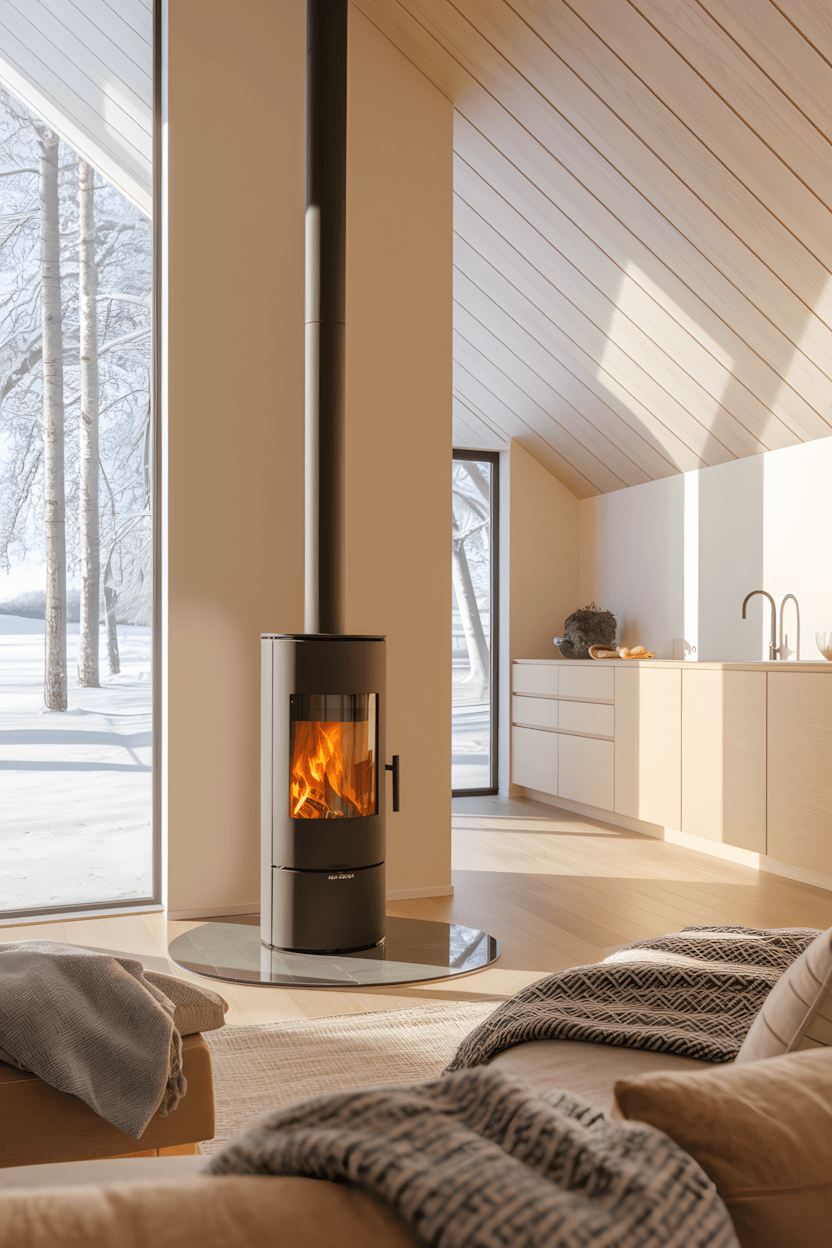
This winter-focused approach demonstrates how Nordic design integrates heating elements as both functional and aesthetic features.
Key Functional Elements:
- Cylindrical wood-burning stove for efficient heating – provides both warmth and visual focal point while using renewable fuel
- Large windows for winter light – maximizes limited daylight while providing connection to winter landscape
- Comfortable seating arrangement – positions furniture to take advantage of both stove heat and natural light
- Light wood paneling for brightness – reflects available light while providing natural insulation
Heating integration: Traditional Nordic stoves serve as room focal points while providing efficient, sustainable heating that creates gathering spaces.
4. Open Concept with Nature Connection
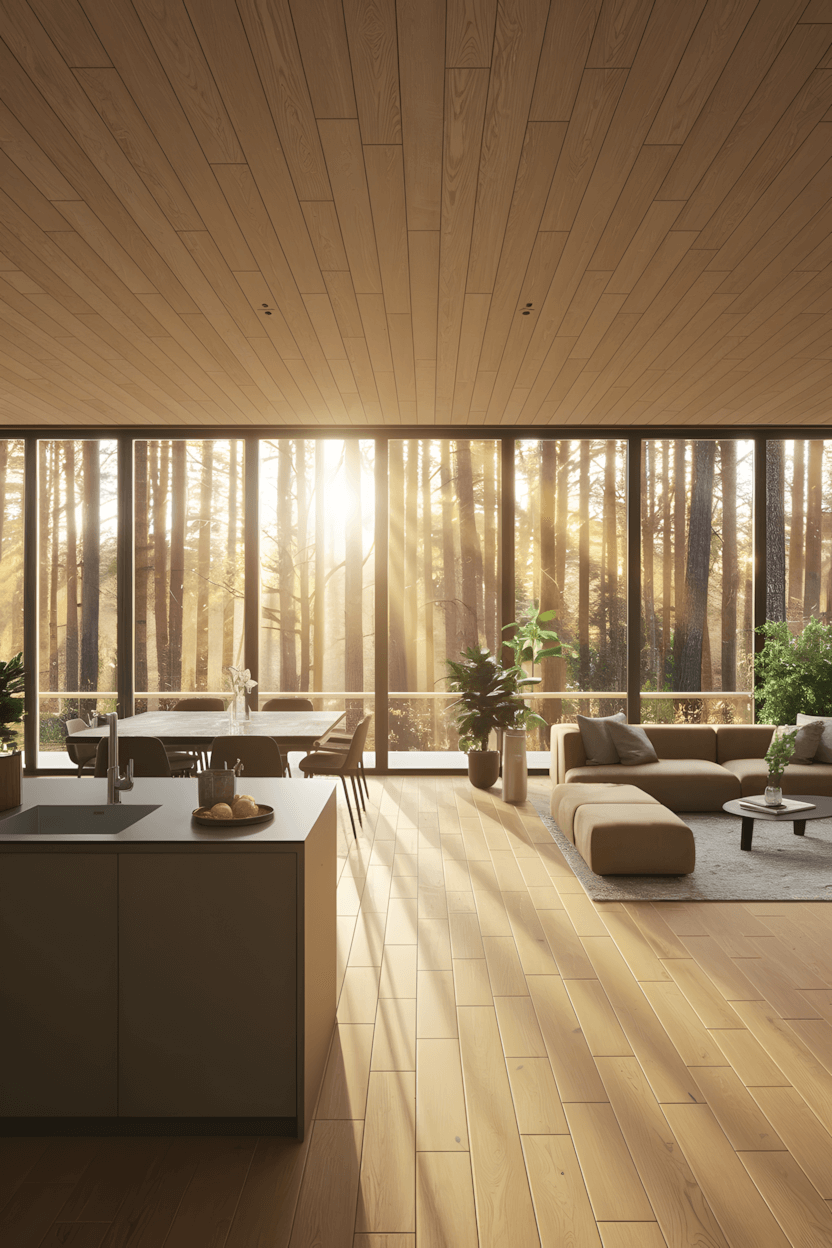
This spacious approach shows how Nordic design uses natural materials to create cohesion in large, open spaces.
Key Functional Elements:
- Floor-to-ceiling windows for landscape integration – maintains visual connection to nature essential for Nordic well-being
- Wooden paneling for material consistency – creates visual unity while providing natural insulation and acoustic benefits
- Open kitchen island for efficient workflow – supports Nordic emphasis on functional, family-centered cooking
- Natural light prioritization – reduces artificial lighting needs while supporting circadian rhythms
Open space strategy: Large Nordic spaces use natural materials and consistent finishes to maintain warmth and intimacy despite size.
Light and View Optimization
5. Window-Focused Living with Seasonal Views
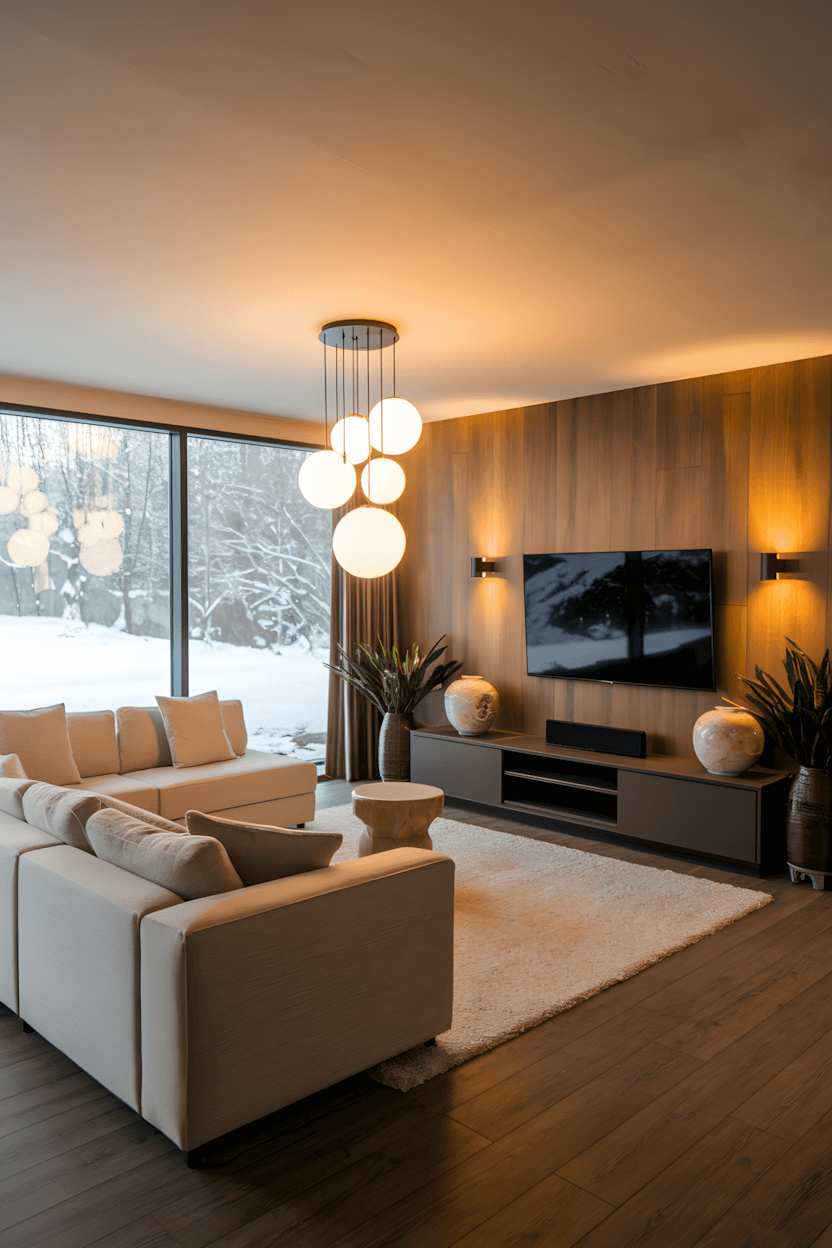
This light-centered approach demonstrates how Nordic design prioritizes natural light and seasonal change awareness.
Key Functional Elements:
- Large sectional positioned for view – maximizes appreciation of changing seasonal landscape
- Artistic pendant lighting for winter evenings – provides beautiful illumination when natural light is limited
- Built-in entertainment integration – keeps technology organized while maintaining clean visual lines
- White rug for light reflection – bounces available light throughout space while providing comfort
Seasonal awareness: Nordic design acknowledges and celebrates seasonal changes rather than trying to create static environments.
6. Hallway Storage with Display Function
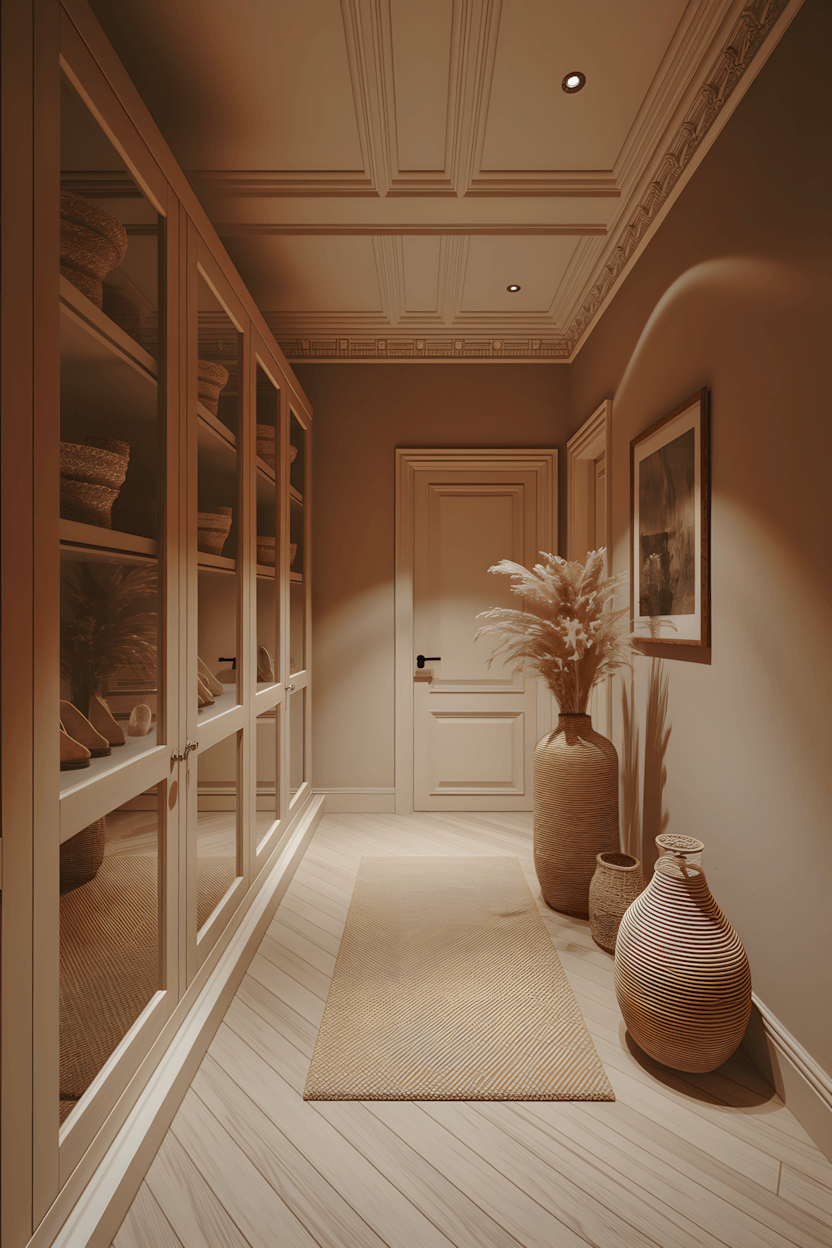
This transitional space approach shows how Nordic design maximizes functionality in every area of the home.
Key Functional Elements:
- Glass-front storage for organized display – keeps items accessible while maintaining visual order
- Herringbone wood flooring for elegance – uses traditional pattern that adds interest without overwhelming
- Artwork integration for personality – adds individual character while maintaining clean aesthetic
- Natural basket storage – provides flexible organization using traditional Nordic materials
Storage philosophy: Nordic storage solutions combine functionality with beauty, treating organization as part of the aesthetic.
7. Dining Room with Natural Light Focus
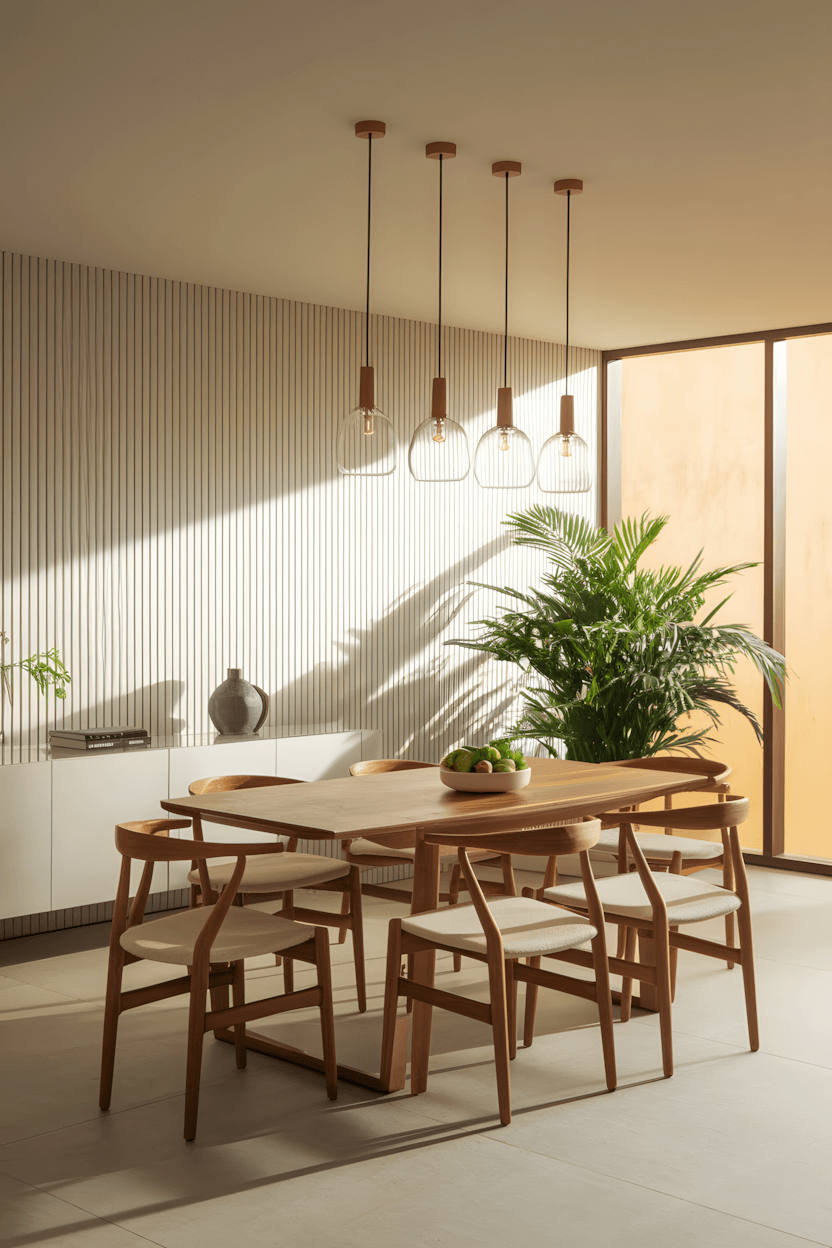
This meal-centered approach demonstrates how Nordic design enhances the important cultural tradition of shared dining.
Key Functional Elements:
- Wooden table for authentic material warmth – provides durable surface that improves with use and age
- Glass pendant lighting for task focus – ensures adequate illumination for food presentation and conversation
- Large window for natural illumination – reduces artificial lighting needs while connecting to outdoor environment
- Textured wall design for acoustic comfort – improves sound quality during conversation while adding visual interest
Dining culture: Nordic dining spaces support the cultural tradition of long, leisurely meals with family and friends.
Kitchen and Functional Areas
8. Scandinavian Kitchen with Open Storage
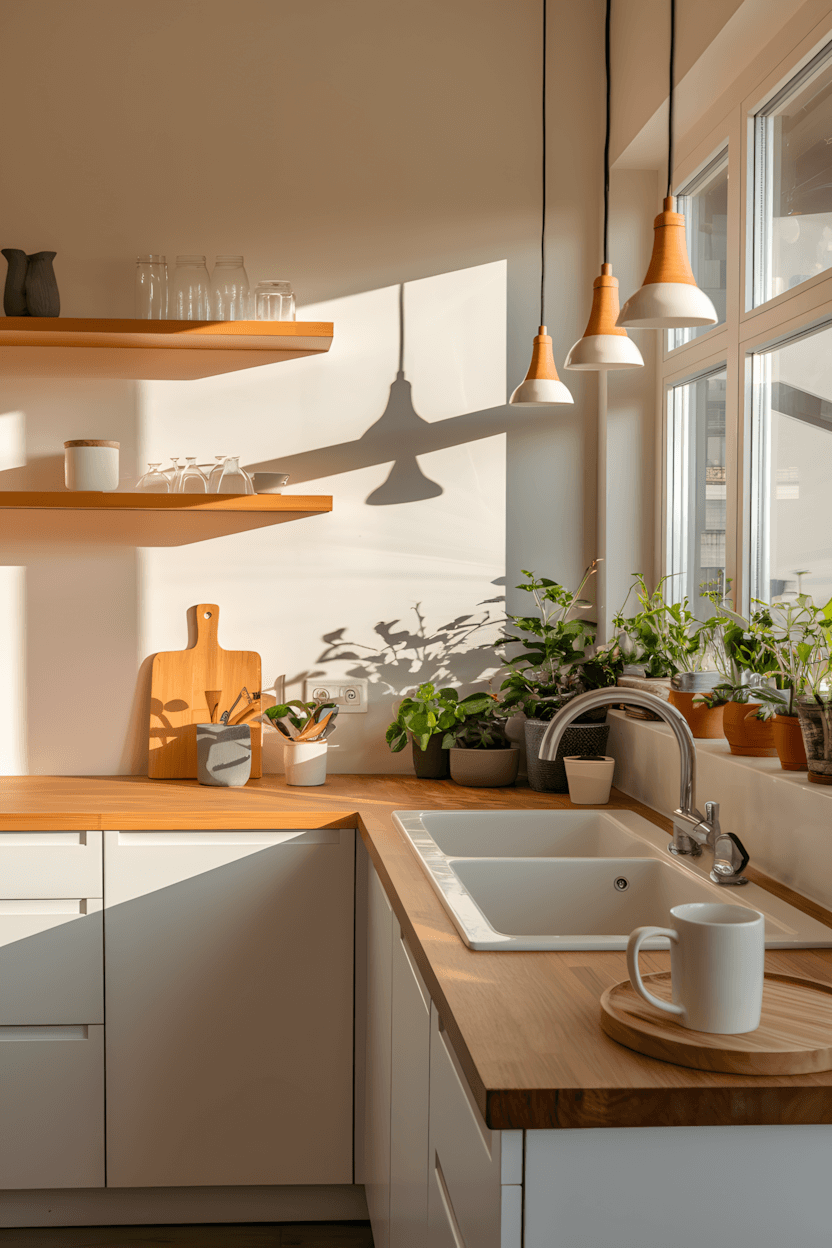
This cooking-focused approach shows how Nordic kitchens balance efficiency with the display of beautiful, functional items.
Key Functional Elements:
- White cabinets for light reflection – maximizes brightness essential in Nordic kitchens during winter months
- Wooden countertops for warmth – provides natural work surface that’s comfortable to touch and naturally antibacterial
- Open shelving for accessible storage – keeps frequently used items within easy reach while displaying beautiful cookware
- Natural window light for food preparation – provides proper illumination for cooking tasks while reducing energy use
Kitchen functionality: Nordic kitchens prioritize function and efficiency while maintaining beauty through quality materials and organization.
9. Living Room with Heating Focus
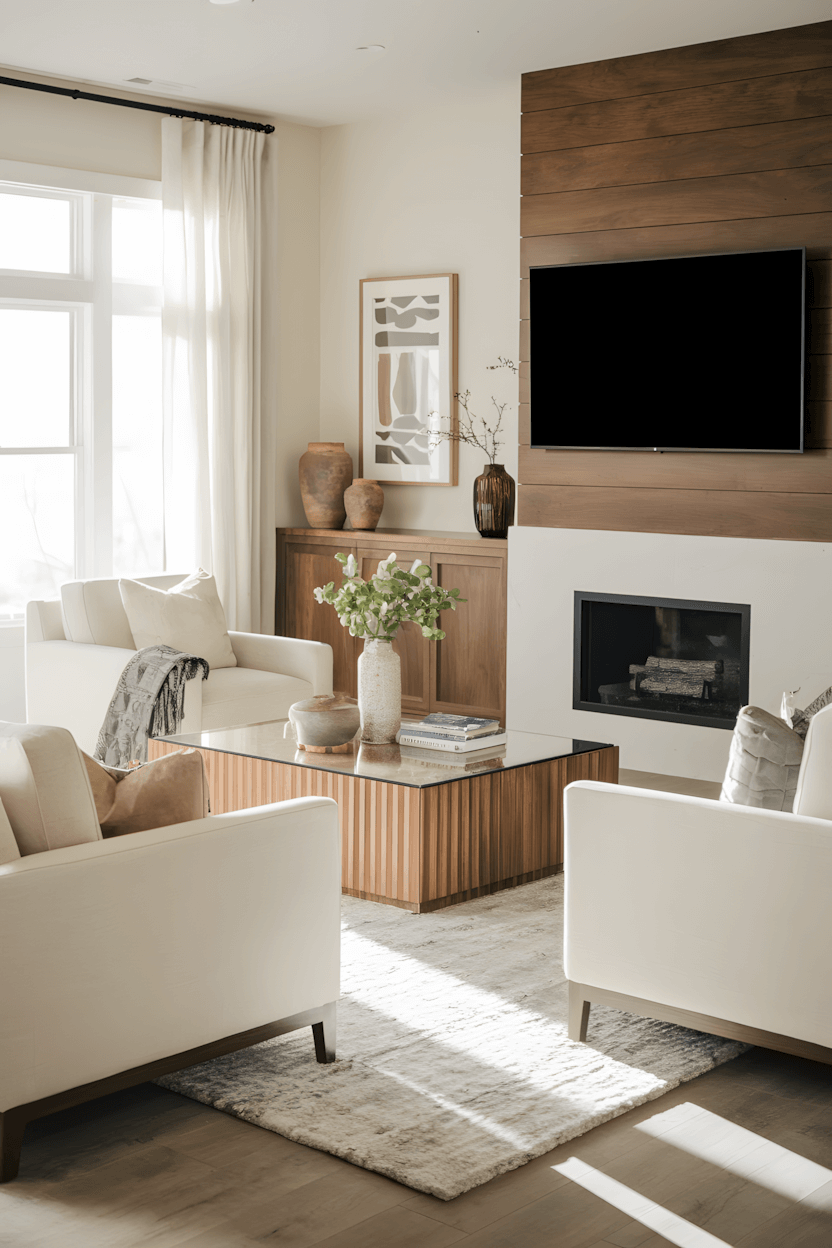
This comfort-centered approach demonstrates how Nordic design organizes spaces around heat sources for optimal comfort.
Key Functional Elements:
- Seating arranged around fireplace – creates natural gathering space that takes advantage of heat source
- Glass coffee table for light transmission – maintains visual openness while providing functional surface
- Built-in entertainment center – integrates technology while maintaining clean lines and organization
- Natural plant integration – improves air quality while providing connection to nature during indoor-focused seasons
Heat-centered planning: Traditional Nordic rooms organize around heating sources, creating natural social gathering areas.
10. Neutral Living with Texture Variety
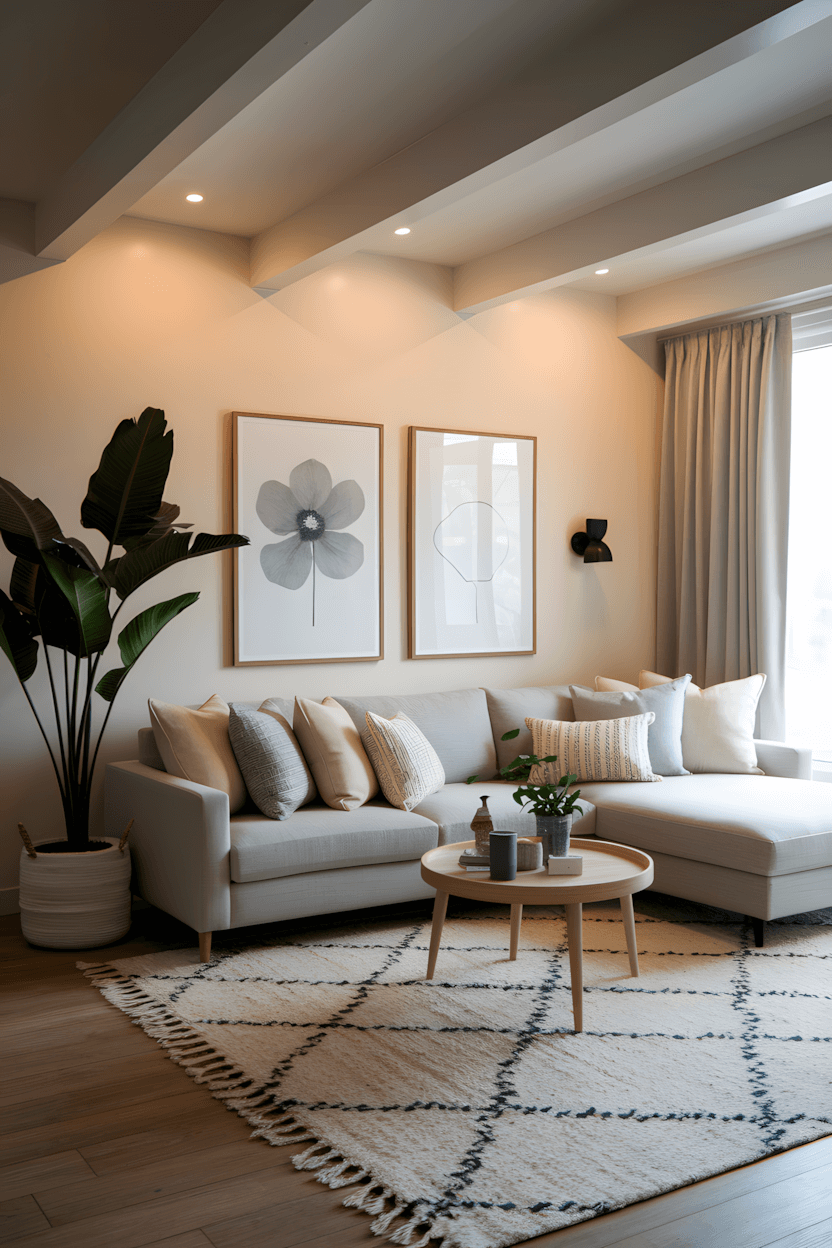
This comfort-focused approach shows how Nordic design uses texture to create visual interest without color complexity.
Key Functional Elements:
- Light gray seating for sophisticated neutrality – provides comfortable foundation that works with changing seasonal décor
- Round wooden table for social interaction – creates intimate conversation area with natural material warmth
- Ceiling beam exposure for authentic architecture – showcases structural elements as decorative features
- Layered textile textures – adds comfort and visual interest through natural material variations
Texture strategy: Nordic design relies on material and texture variation rather than color for visual interest and comfort.
Minimalist and Calm Spaces
11. Garden-Connected Minimalist Living
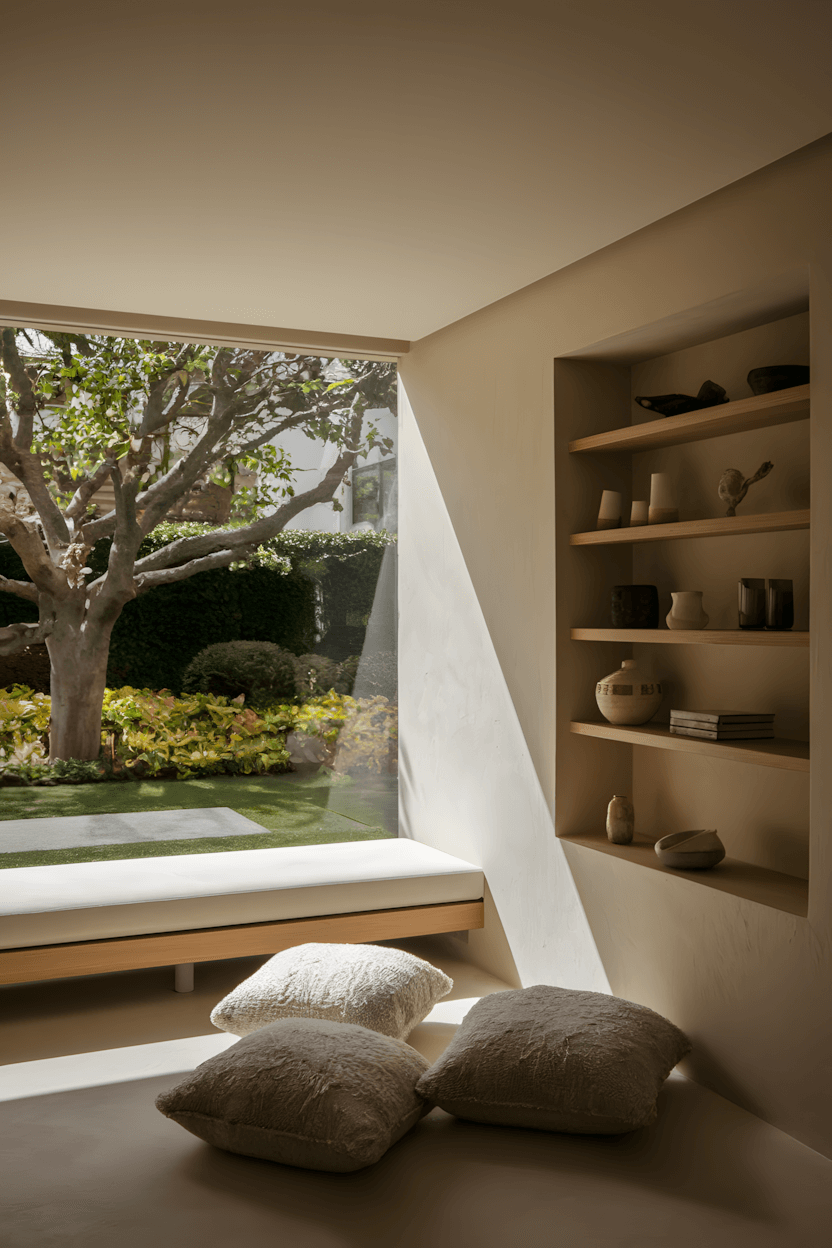
This nature-focused approach demonstrates how Nordic design maintains strong connections to outdoor environments.
Key Functional Elements:
- Built-in storage for clean organization – eliminates visual clutter while providing necessary storage
- Window bench for outdoor viewing – creates comfortable spot for appreciating garden and seasonal changes
- Floor cushions for flexible seating – provides adaptable seating that can be easily stored or rearranged
- Garden view prioritization – positions seating to maximize appreciation of outdoor natural beauty
Indoor-outdoor connection: Nordic design maintains strong visual and psychological connections to nature throughout the year.
12. Sophisticated Living with Quality Materials
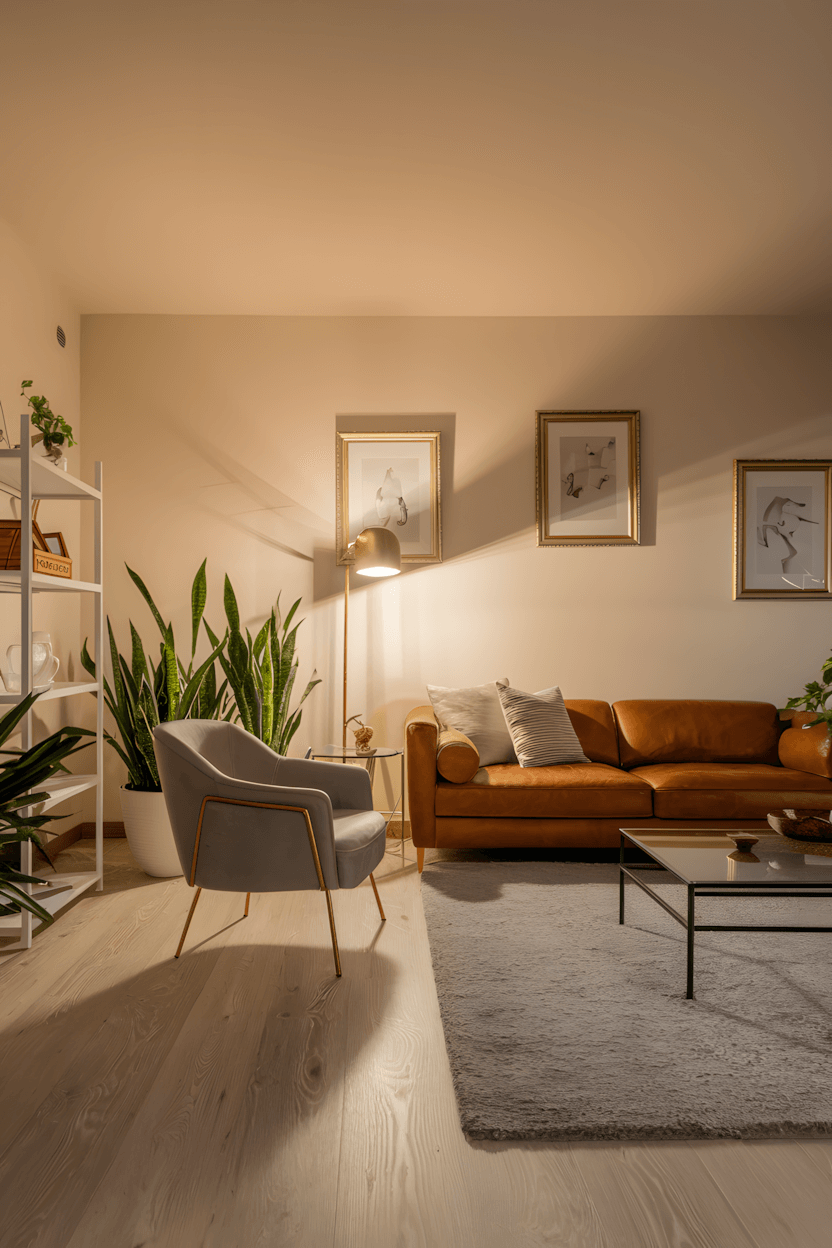
This refined approach shows how Nordic design can incorporate luxury elements while maintaining essential simplicity.
Key Functional Elements:
- Leather seating for durability and comfort – provides long-lasting furniture that improves with age
- Gold accent coordination – adds warmth through metallic elements without overwhelming neutral palette
- Quality storage display – showcases beautiful objects while maintaining organization
- Plant integration for air quality – improves indoor environment while providing natural beauty
Quality over quantity: Nordic design philosophy emphasizes fewer, higher-quality pieces that provide lasting satisfaction.
13. Modern Kitchen with Timeless Materials
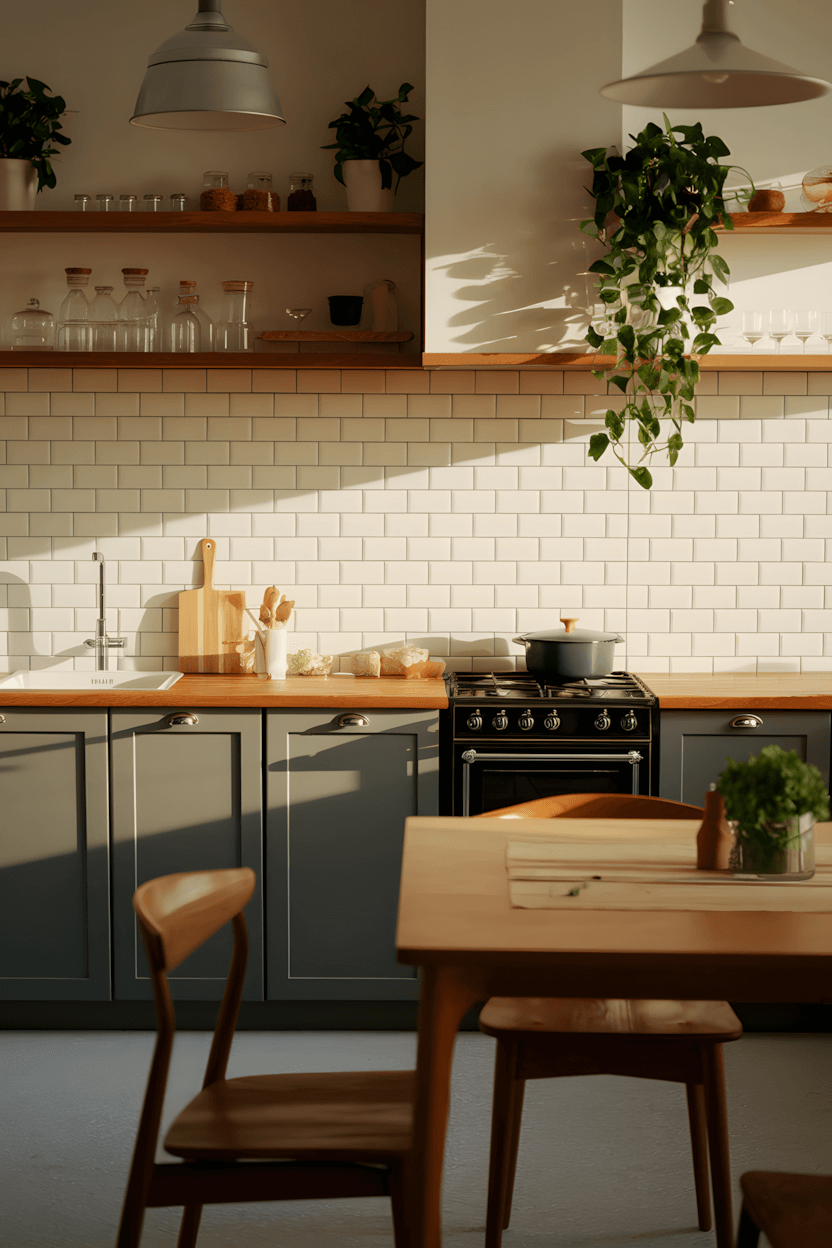
This cooking-focused approach demonstrates how Nordic kitchens can incorporate contemporary elements while maintaining traditional values.
Key Functional Elements:
- Gray cabinetry for sophisticated neutrality – provides elegant foundation that hides wear better than pure white
- Wooden countertops for natural warmth – offers sustainable material that provides comfort and authentic beauty
- Subway tile backsplash for easy maintenance – uses proven material that provides practical function and timeless appeal
- Pendant lighting for task illumination – ensures proper lighting for food preparation while adding design interest
Kitchen evolution: Modern Nordic kitchens can incorporate contemporary conveniences while maintaining essential material authenticity.
14. Reading Nook with Natural Light
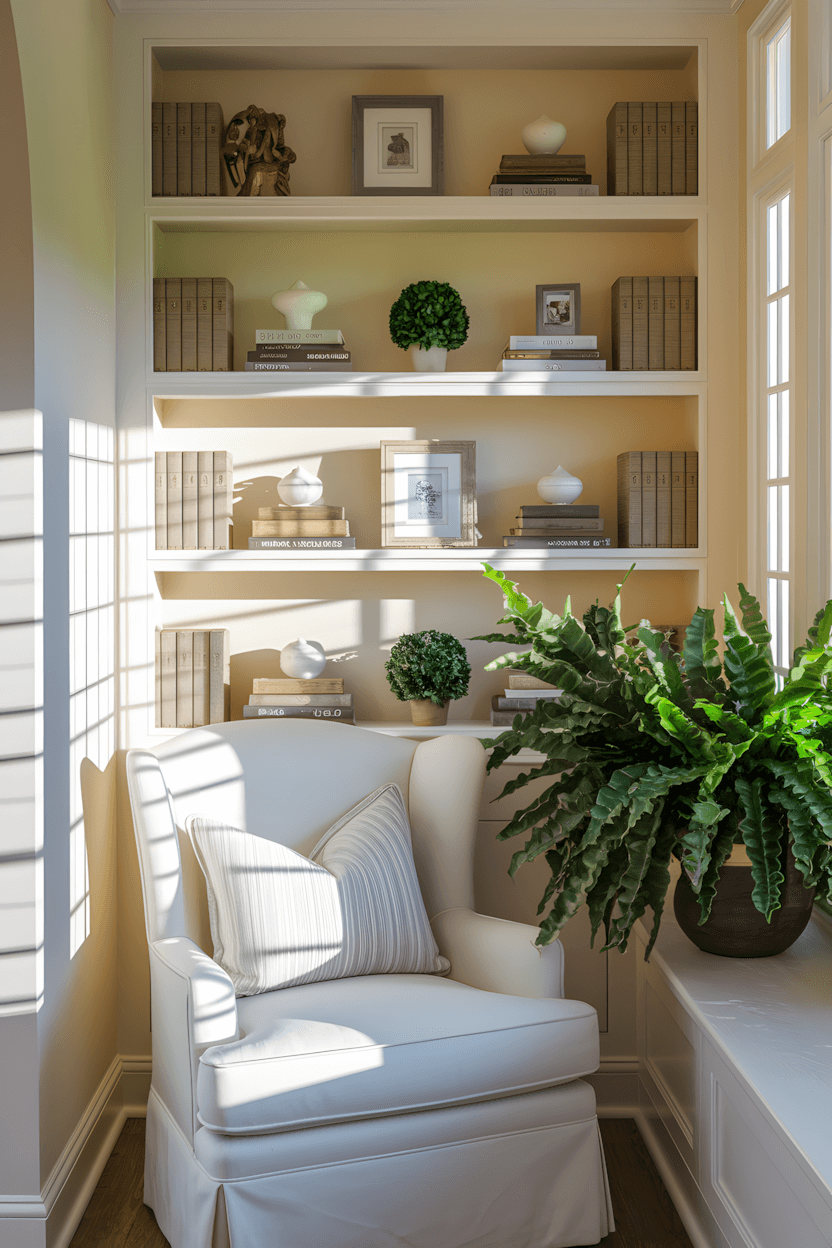
This quiet space approach shows how Nordic design creates dedicated areas for contemplation and relaxation.
Key Functional Elements:
- Window-positioned seating for natural light – provides ideal reading conditions while maintaining connection to outdoors
- Built-in storage for book organization – keeps reading materials accessible while maintaining clean appearance
- Comfortable seating for extended use – ensures physical comfort during long reading sessions
- Natural light optimization – reduces eye strain while providing vitamin D benefits during limited daylight periods
Contemplative space: Nordic design includes quiet areas that support mental well-being and personal reflection.
Industrial and Contemporary Fusion
15. Industrial Nordic Blend
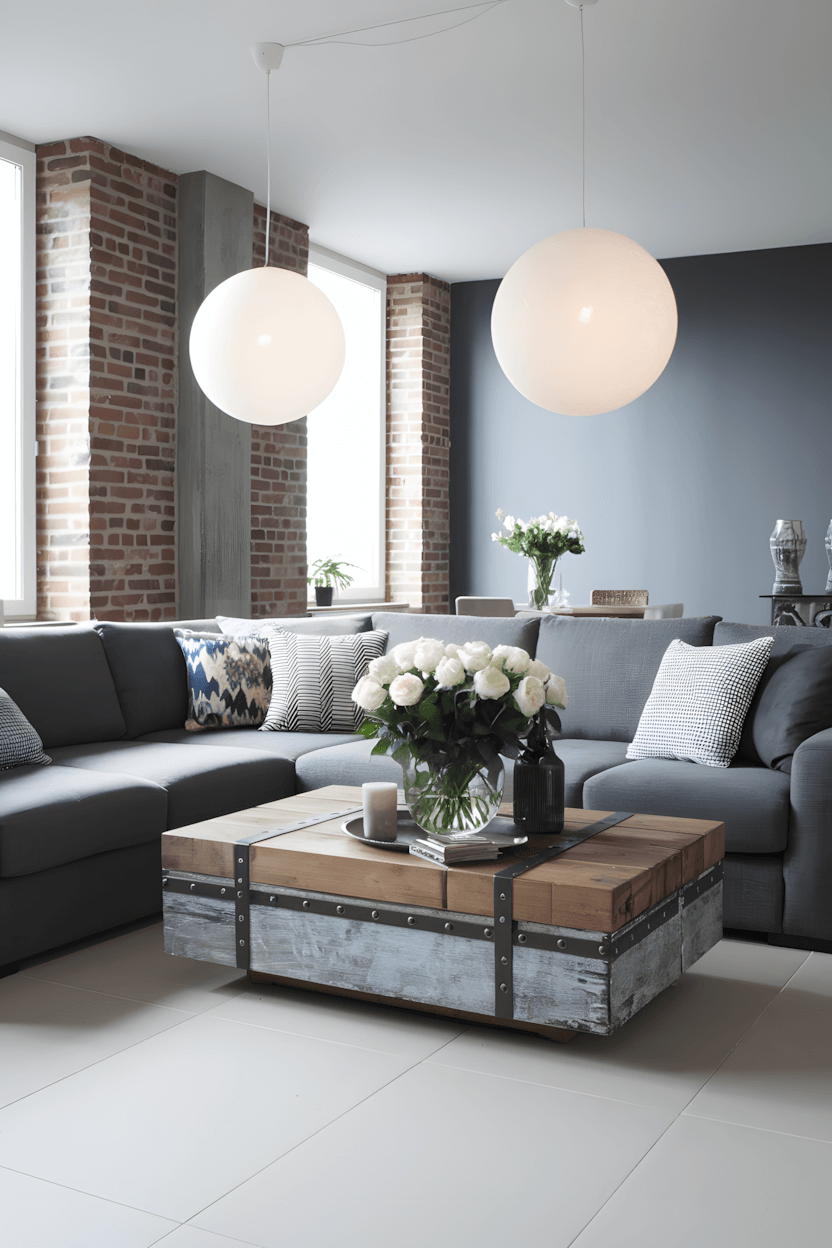
This urban approach demonstrates how Nordic principles can adapt to contemporary city living while maintaining essential character.
Key Functional Elements:
- Exposed brick for authentic texture – provides thermal mass and urban character while maintaining Nordic natural material emphasis
- Gray seating for sophisticated comfort – offers durable, comfortable furniture appropriate for both relaxation and entertaining
- Industrial lighting for task function – provides adequate illumination while adding contemporary design interest
- Textile softening elements – balances hard industrial materials with Nordic comfort tradition
Urban adaptation: Nordic design principles work effectively in urban environments when adapted thoughtfully to city living conditions.
16. Mountain Retreat with Dramatic Views
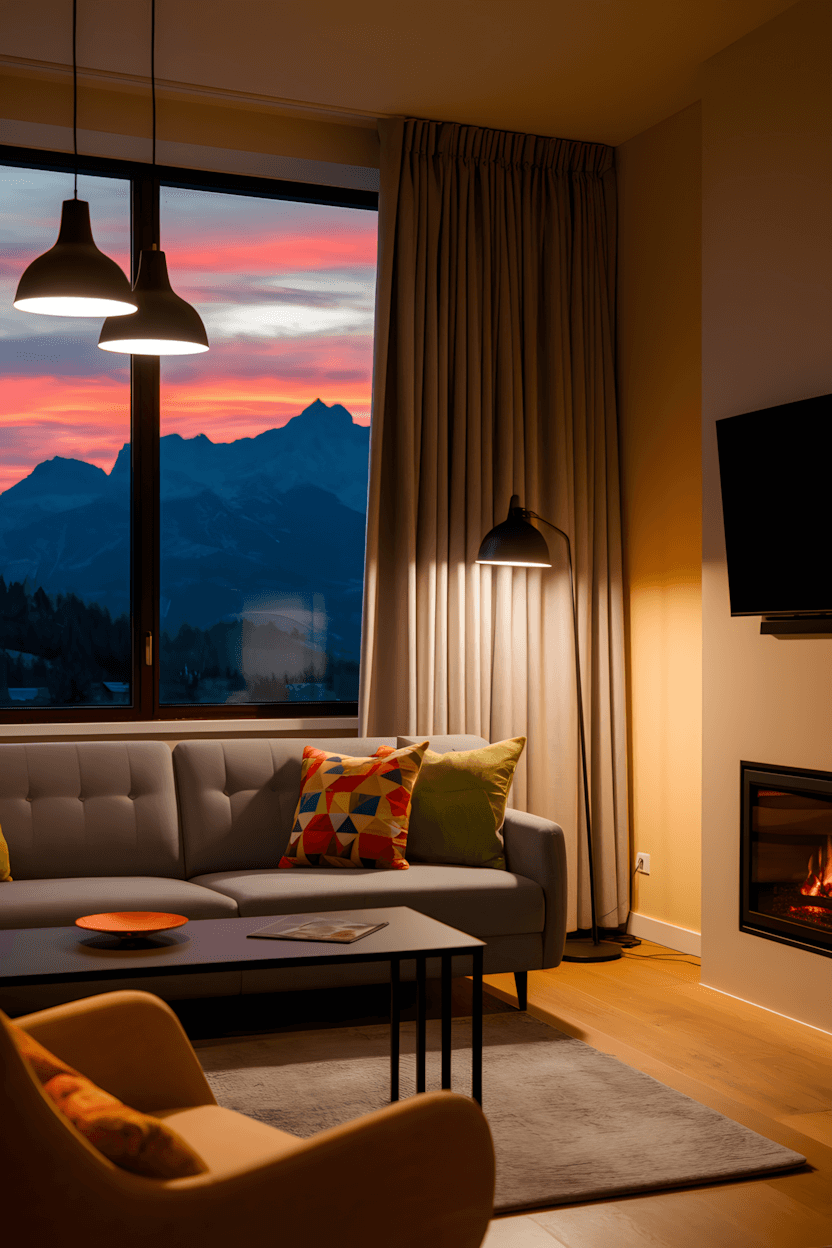
This location-specific approach shows how Nordic design can enhance spectacular natural settings.
Key Functional Elements:
- View-focused furniture arrangement – positions seating to maximize appreciation of natural landscape
- Fireplace for warmth and atmosphere – provides both practical heating and social gathering focal point
- Quality lighting for evening comfort – ensures functionality when natural light is limited
- Mountain-appropriate materials – uses finishes and furniture that complement rather than compete with natural setting
Site-specific design: Nordic principles adapt to take advantage of specific natural features and climatic conditions.
17. Kitchen Island with Contemporary Function
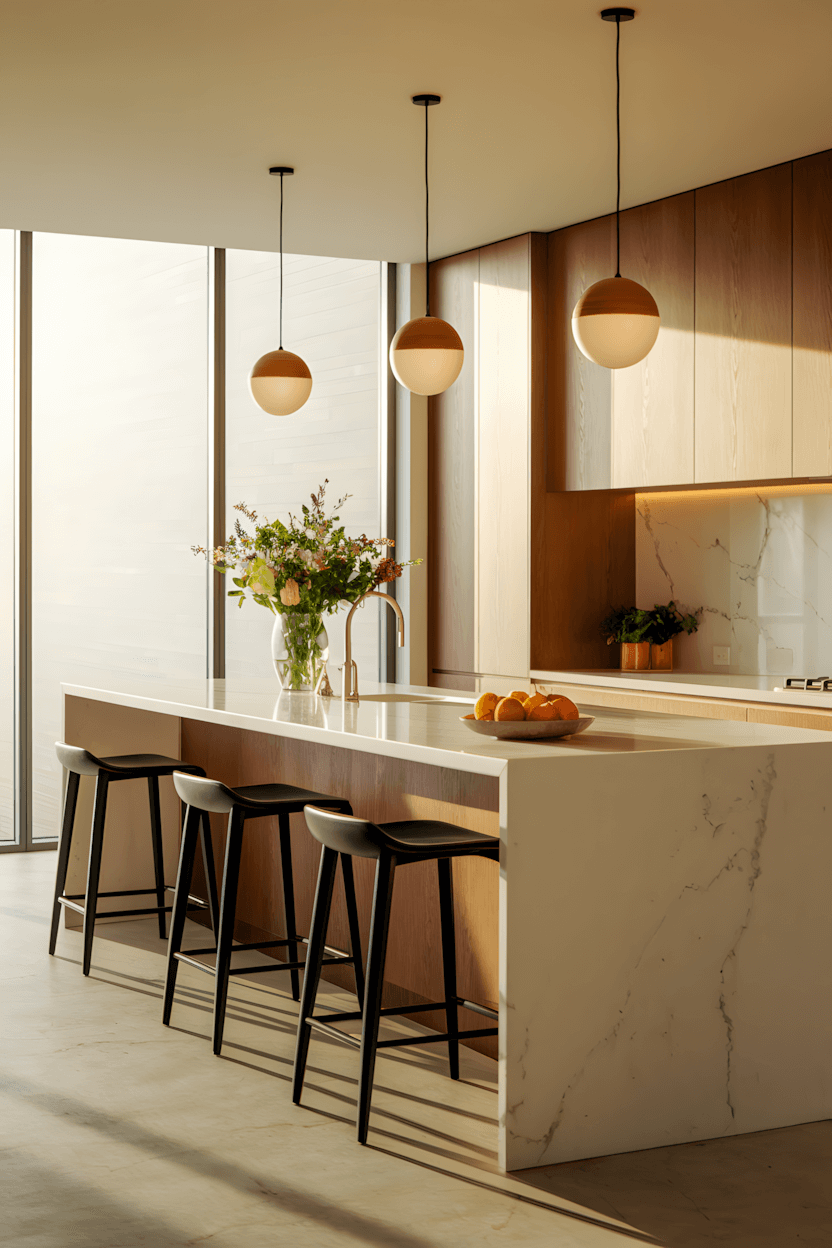
This cooking-centered approach demonstrates how Nordic kitchens can accommodate modern appliances and workflow needs.
Key Functional Elements:
- Central island for efficient workflow – creates efficient food preparation area while providing social cooking space
- Mixed material coordination – combines white, wood, and stone for visual interest while maintaining Nordic natural material emphasis
- Large window natural light – provides proper illumination for cooking tasks while maintaining outdoor connection
- Quality appliance integration – incorporates modern convenience while maintaining clean visual lines
Modern functionality: Contemporary Nordic kitchens successfully integrate modern appliances and workflow efficiency with traditional material values.
Workspace and Multi-Function Areas
18. Loft Living with Work Integration
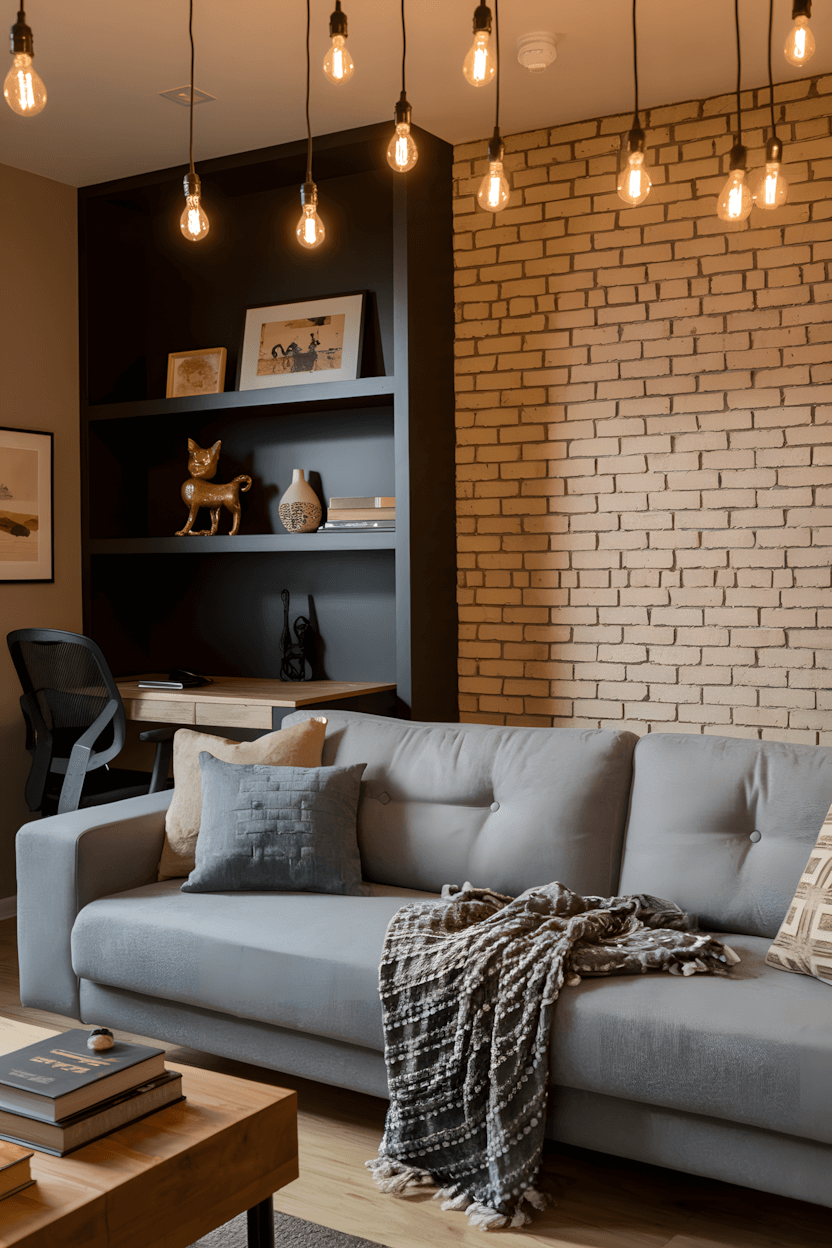
This multi-functional approach shows how Nordic design can accommodate modern work-from-home needs.
Key Functional Elements:
- Workspace near window for natural light – provides ideal working conditions while maintaining connection to outdoors
- Flexible seating arrangement – accommodates both work and relaxation functions within single space
- Industrial lighting for task focus – ensures adequate illumination for detailed work while adding design character
- Open layout for space efficiency – maximizes usable area while maintaining Nordic emphasis on uncluttered living
Work-life integration: Modern Nordic design accommodates professional work needs while maintaining home comfort and character.
19. Contemporary Kitchen with Traditional Elements
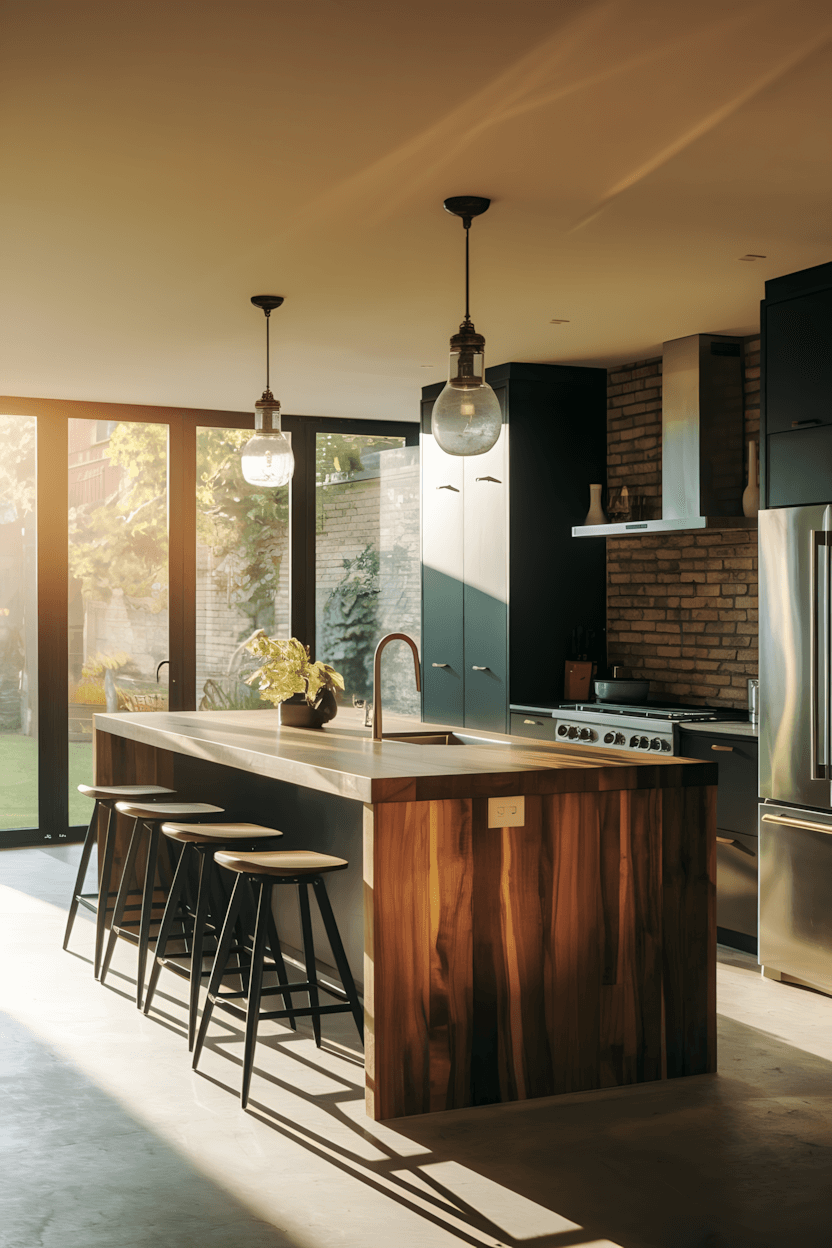
This cooking space approach demonstrates how Nordic design can honor tradition while embracing contemporary convenience.
Key Functional Elements:
- Wooden island for natural material authenticity – provides workspace using traditional Nordic materials
- Vintage lighting for character – adds personality while providing necessary task illumination
- Mixed material palette – combines traditional wood with contemporary surfaces for functional efficiency
- Natural light optimization – uses windows strategically to provide cooking illumination while maintaining energy efficiency
Tradition and innovation: Successful Nordic design honors traditional values while adapting to contemporary lifestyle needs.
20. Nordic Kitchen with Structural Character
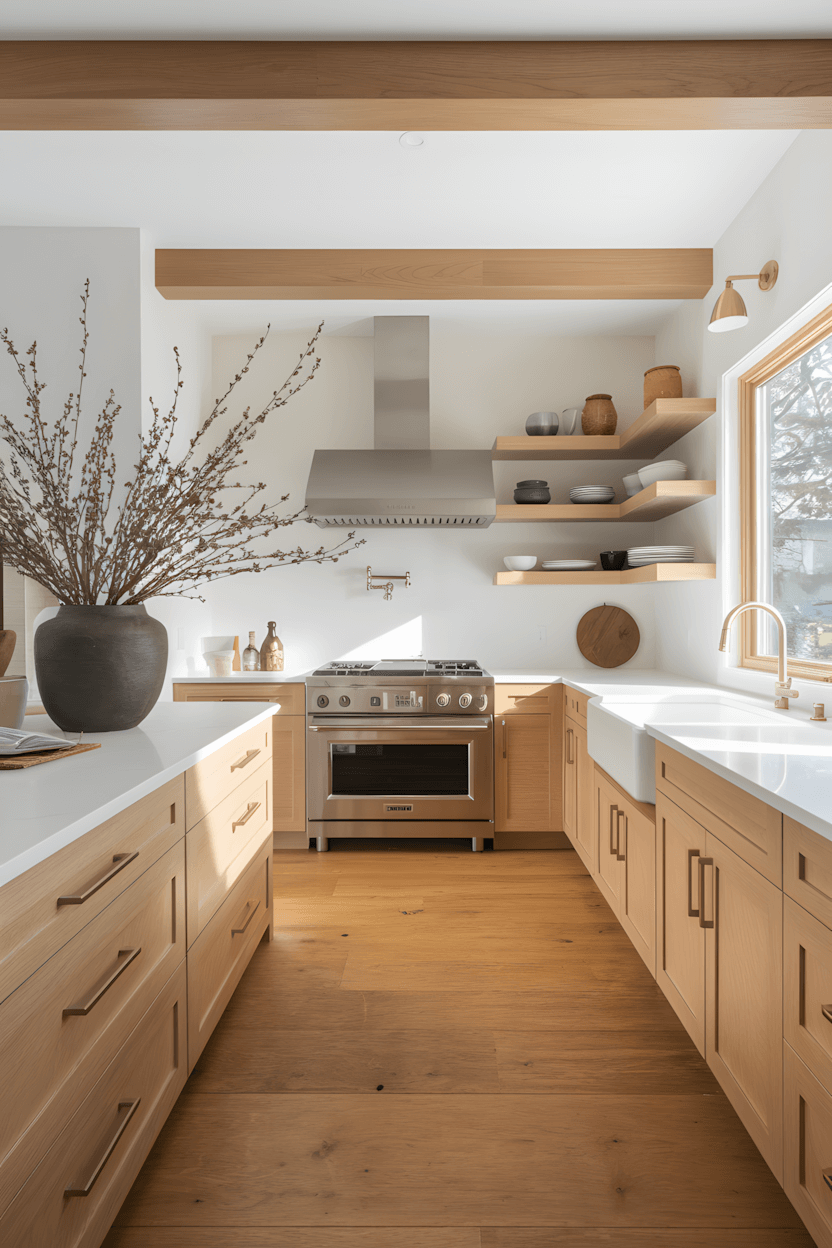
This architectural approach shows how Nordic design can showcase building structure as decorative element.
Key Functional Elements:
- Exposed wooden beams for authentic architecture – celebrates structural elements while providing visual interest
- Light wood cabinetry for brightness – maximizes light reflection while providing natural material authenticity
- Open shelving for functional display – keeps cooking essentials accessible while showcasing beautiful items
- Stainless steel appliances for professional function – provides contemporary cooking capability while maintaining clean aesthetic
Structural honesty: Nordic design celebrates rather than hides building structure, treating architectural elements as decorative features.
Luxury and Comfort Integration
21. Winter Retreat with Ultimate Comfort
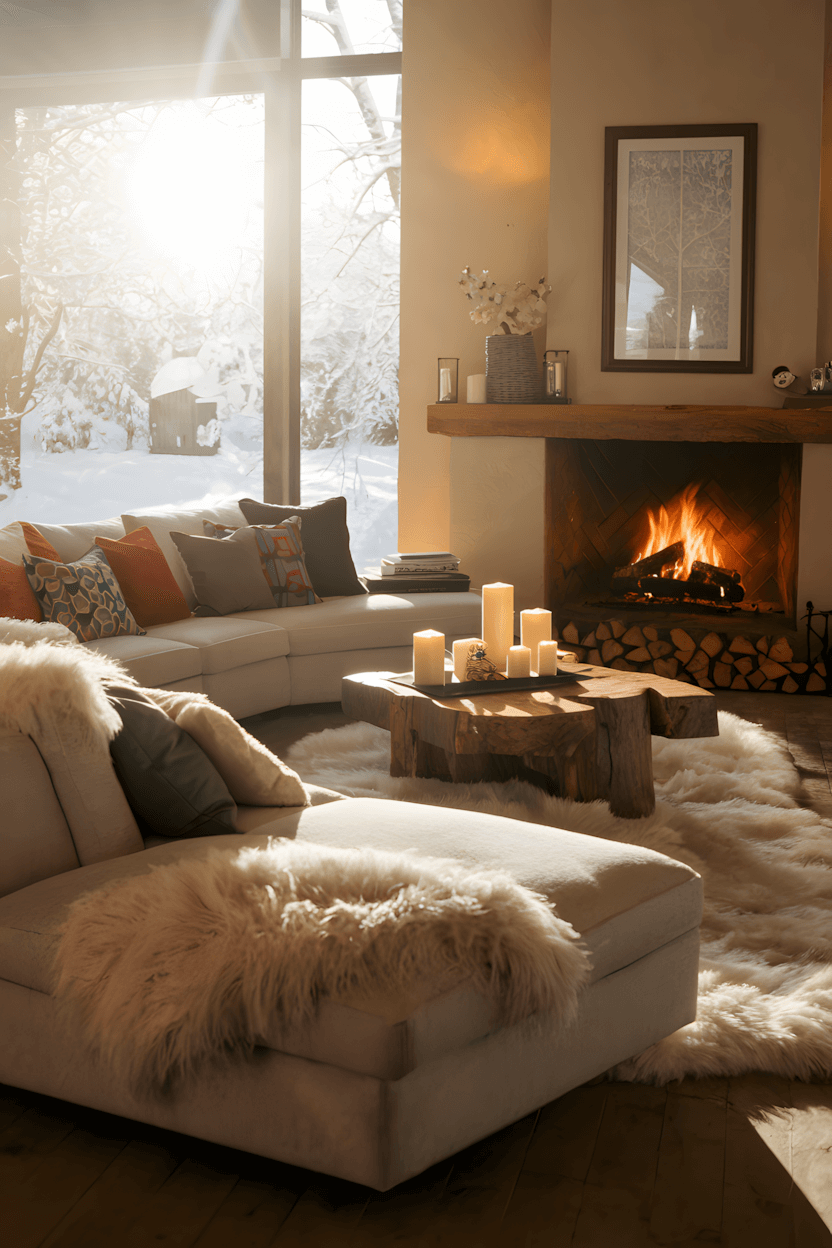
This seasonal approach demonstrates how Nordic design creates optimal comfort during challenging winter conditions.
Key Functional Elements:
- Large sectional for family gathering – provides ample seating for extended indoor time during winter months
- Fireplace for both heat and atmosphere – creates physical warmth and psychological comfort during cold seasons
- Textile layering for warmth and comfort – uses natural materials to provide physical comfort and visual softness
- Candle lighting for evening atmosphere – creates welcoming ambiance during long winter evenings
Winter comfort: Nordic design addresses the specific comfort needs created by long, cold winter seasons.
22. Elegant Kitchen with Premium Materials
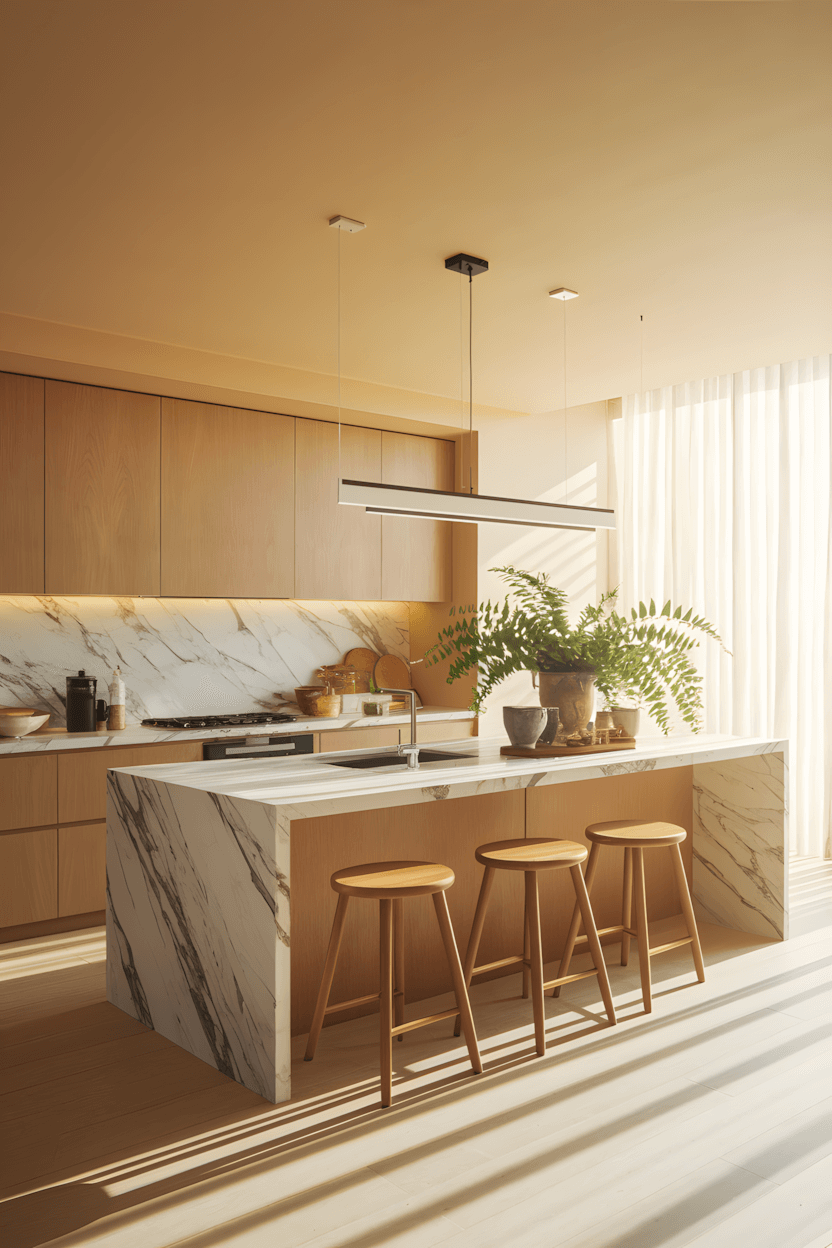
This sophisticated approach shows how Nordic design can incorporate luxury elements while maintaining essential functionality.
Key Functional Elements:
- Marble backsplash for elegant durability – provides beautiful, easy-to-clean surface that improves kitchen function
- Wooden cabinetry for natural warmth – uses traditional material that provides lasting beauty and functionality
- Contemporary lighting for task efficiency – ensures proper illumination for food preparation while adding design interest
- Island seating for social cooking – accommodates family interaction during meal preparation
Accessible luxury: Nordic luxury focuses on quality materials and functionality rather than ostentatious display.
23. Spa-Inspired Bathroom with Nature Connection
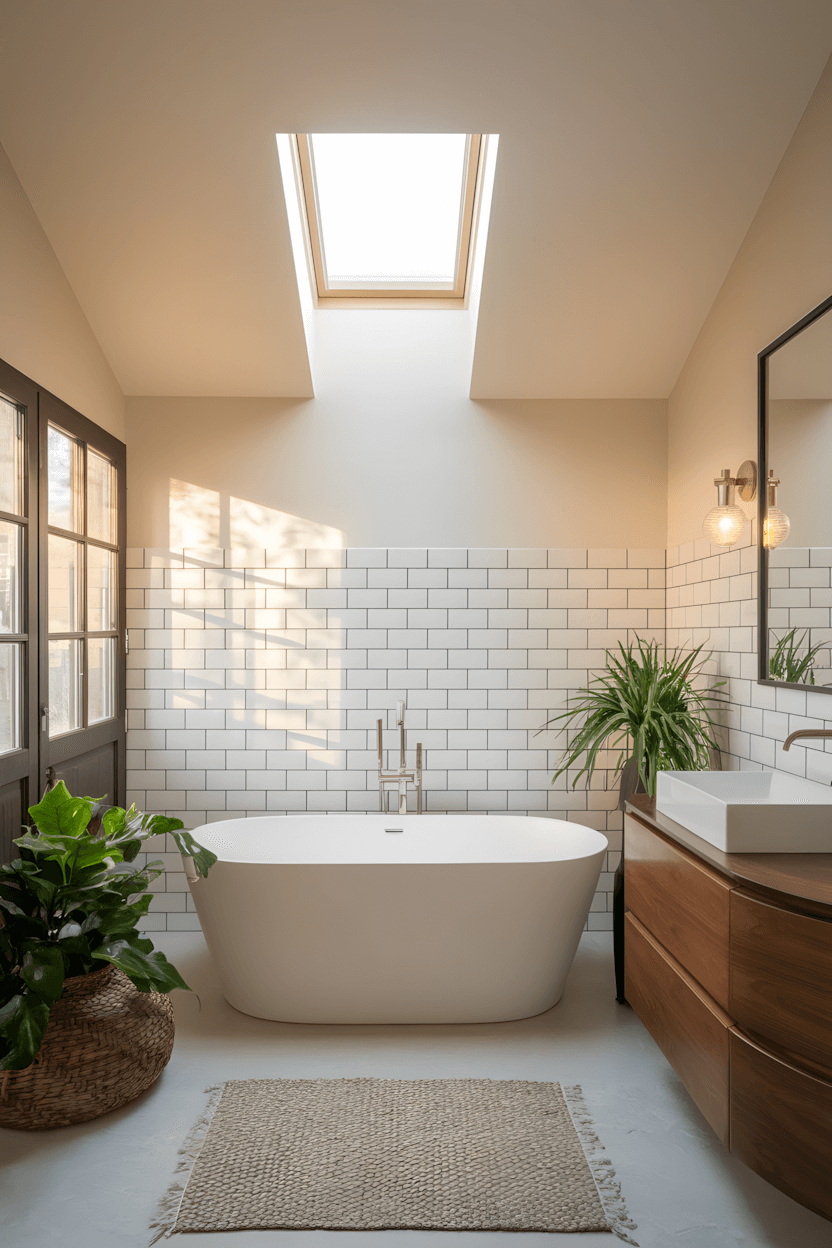
This wellness-focused approach demonstrates how Nordic design creates restorative personal spaces.
Key Functional Elements:
- Freestanding tub for relaxation – provides spa-like experience that supports wellness and stress relief
- Large window for natural light and views – maintains connection to nature while providing proper lighting
- Natural materials for authentic comfort – uses wood and stone that provide tactile comfort and authentic beauty
- Plant integration for air quality – improves bathroom environment while providing natural beauty
Wellness focus: Nordic bathrooms prioritize relaxation and connection to nature as essential for personal well-being.
24. Bright Living with Soft Comfort
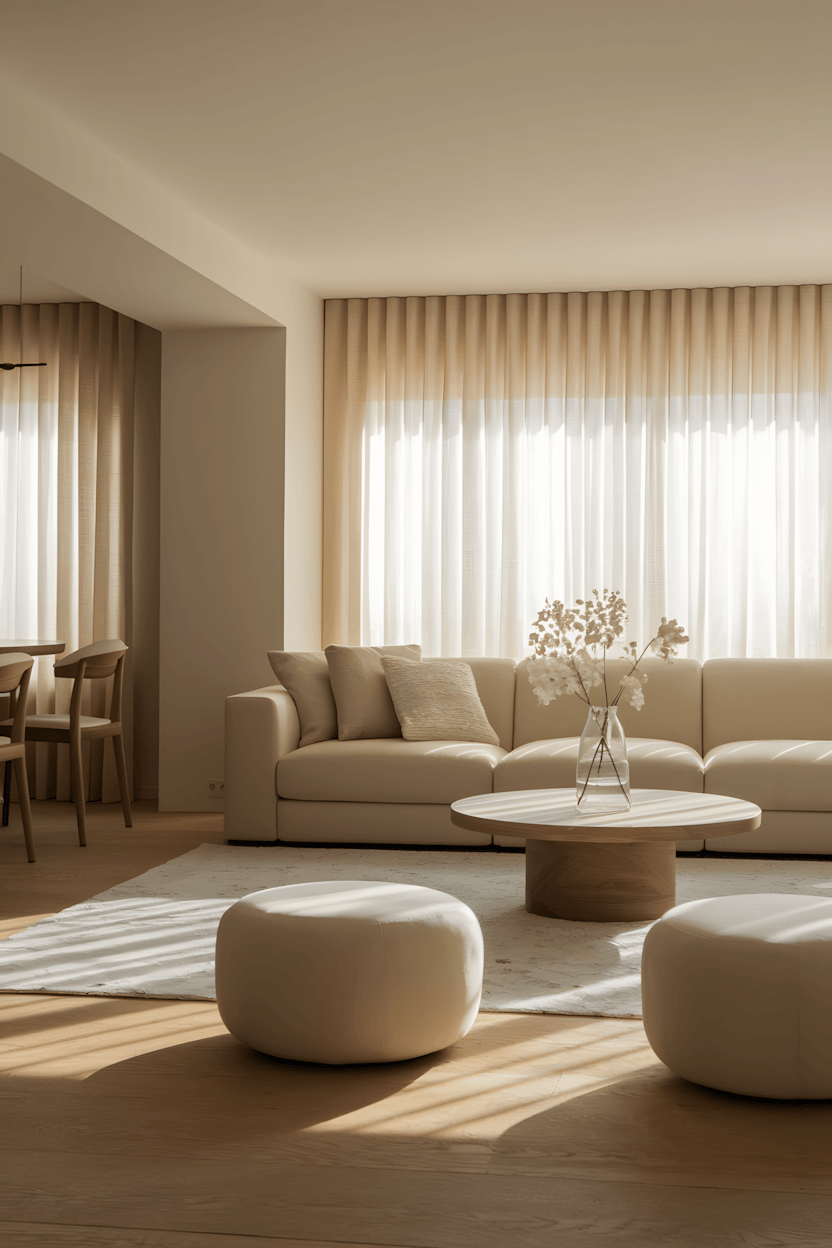
This light-focused approach shows how Nordic design creates cheerful, comfortable environments.
Key Functional Elements:
- Light-colored seating for brightness – maximizes light reflection while providing comfortable gathering space
- Round table for intimate conversation – creates social focal point that encourages family interaction
- Multiple seating options for flexibility – accommodates various activities and group sizes
- Natural light maximization – uses windows strategically to provide illumination and mood benefits
Brightness strategy: Nordic design uses light colors and strategic planning to maximize available natural light.
25. Open Concept Integration
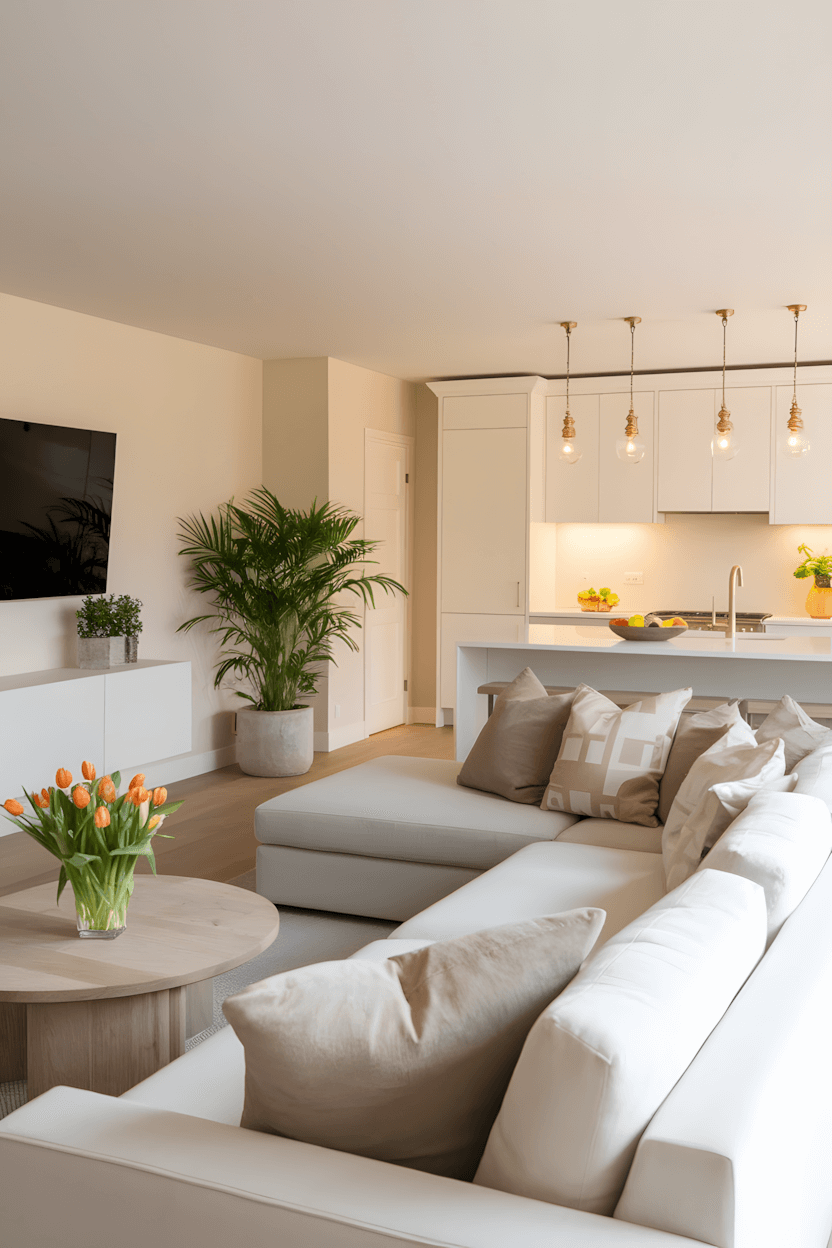
This comprehensive approach demonstrates how Nordic design can create seamless flow between living areas.
Key Functional Elements:
- L-shaped seating for space definition – creates living area boundaries within open floor plan
- Kitchen island for workflow efficiency – provides food preparation space while maintaining connection to living areas
- Consistent material palette – uses unified finishes to create visual cohesion across different functional areas
- Natural light flow – positions spaces to allow light to move throughout open areas
Open living success: Nordic open concepts succeed through careful material coordination and thoughtful space planning.
Creating Authentic Nordic Interiors
After years of Nordic interior projects, I’ve learned that successful Scandinavian-style interiors balance three essential considerations: authentic material choices that provide both beauty and function, space planning that supports Nordic cultural values of family connection and nature appreciation, and lighting design that addresses the unique challenges and opportunities of northern climates.
The Nordic interiors that families love long-term are those that solve real daily challenges—adequate light during dark months, efficient heating, organized storage, comfortable gathering spaces—while reflecting genuine Nordic values of sustainability, quality, and connection to nature.
Focus on understanding the cultural and practical reasons behind Nordic design choices rather than copying surface aesthetics.
Most importantly, adapt Nordic principles to your specific climate, lifestyle, and family needs. The goal isn’t to recreate a museum of Scandinavian design, but to apply time-tested principles for creating comfortable, functional, beautiful homes that genuinely support well-being and family life.
Which of these authentic Nordic approaches resonates with your vision for comfortable, sustainable, nature-connected living?

